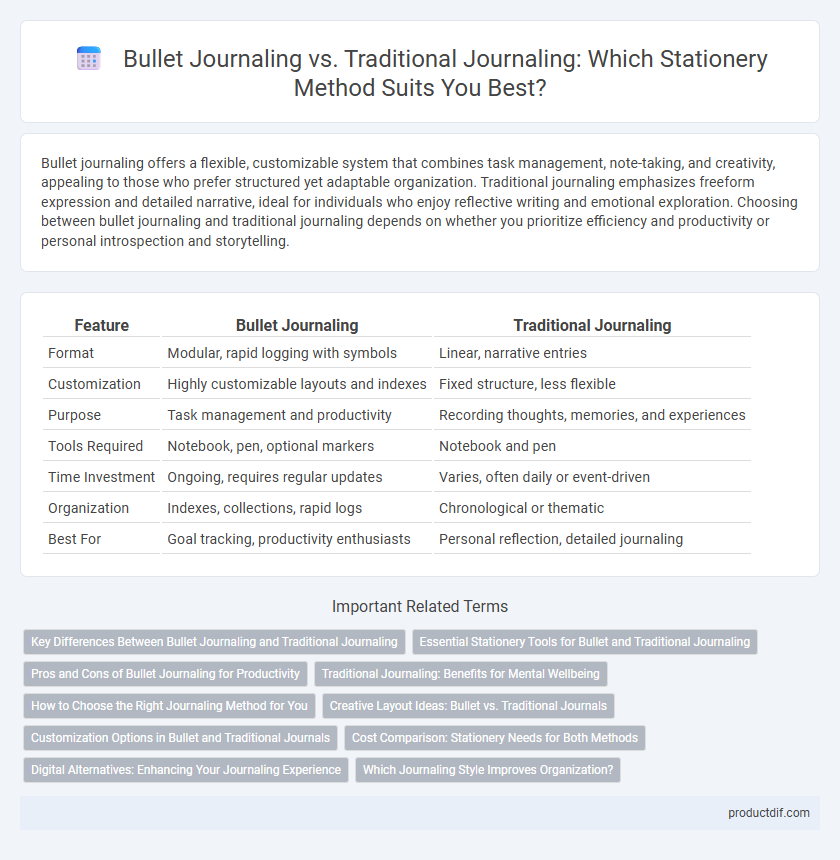Bullet journaling offers a flexible, customizable system that combines task management, note-taking, and creativity, appealing to those who prefer structured yet adaptable organization. Traditional journaling emphasizes freeform expression and detailed narrative, ideal for individuals who enjoy reflective writing and emotional exploration. Choosing between bullet journaling and traditional journaling depends on whether you prioritize efficiency and productivity or personal introspection and storytelling.
Table of Comparison
| Feature | Bullet Journaling | Traditional Journaling |
|---|---|---|
| Format | Modular, rapid logging with symbols | Linear, narrative entries |
| Customization | Highly customizable layouts and indexes | Fixed structure, less flexible |
| Purpose | Task management and productivity | Recording thoughts, memories, and experiences |
| Tools Required | Notebook, pen, optional markers | Notebook and pen |
| Time Investment | Ongoing, requires regular updates | Varies, often daily or event-driven |
| Organization | Indexes, collections, rapid logs | Chronological or thematic |
| Best For | Goal tracking, productivity enthusiasts | Personal reflection, detailed journaling |
Key Differences Between Bullet Journaling and Traditional Journaling
Bullet journaling offers a customizable, modular system using indexed logs, rapid logging, and symbols for tasks, events, and notes, promoting efficiency and organization unlike traditional journaling, which tends to be more free-form and narrative-focused. Traditional journaling emphasizes reflective writing and storytelling without strict formatting, while bullet journaling incorporates structured layouts such as monthly logs, habit trackers, and future logs to enhance productivity. The key difference lies in bullet journaling's blend of planning and creativity versus traditional journaling's emphasis on self-expression and emotional exploration.
Essential Stationery Tools for Bullet and Traditional Journaling
Essential stationery tools for bullet journaling include dotted notebooks, fineliner pens, ruler, and colorful highlighters to create customizable layouts and trackers. Traditional journaling relies on lined or blank notebooks, classic ballpoint or fountain pens, and occasionally stickers or washi tape for decoration. Both methods benefit from quality paper and durable covers to enhance the writing experience and longevity of the journal.
Pros and Cons of Bullet Journaling for Productivity
Bullet journaling enhances productivity by offering customizable layouts that adapt to individual needs and promote organization through rapid logging and task prioritization. Its minimalist design reduces clutter, helping to declutter the mind and increase focus, but requires consistent effort and discipline which can be challenging for some users. Unlike traditional journaling, bullet journaling emphasizes goal-setting and habit tracking, making it a practical tool for time management, though it may lack the expressive freedom of more narrative journaling styles.
Traditional Journaling: Benefits for Mental Wellbeing
Traditional journaling enhances mental wellbeing by providing a structured outlet for emotional expression and self-reflection, which promotes stress reduction and emotional clarity. The consistent practice of writing by hand stimulates cognitive processing and mindfulness, supporting mental resilience and emotional balance. Studies link traditional journaling with improved mood regulation and decreased symptoms of anxiety and depression, making it a valuable tool for psychological health.
How to Choose the Right Journaling Method for You
Choosing the right journaling method depends on your personal goals and creativity level; bullet journaling offers flexible customization with symbols and rapid logging, ideal for those seeking structure and productivity. Traditional journaling emphasizes free-form writing and reflection, better suited for individuals who prefer expressive storytelling and emotional exploration. Evaluate your priorities in organization, creativity, and time commitment to determine which journaling style aligns best with your lifestyle.
Creative Layout Ideas: Bullet vs. Traditional Journals
Bullet journaling offers versatile grid-based layouts that enhance customization with indexed sections, rapid logging, and habit trackers, enabling personalized creative organization. Traditional journaling relies on freeform entries and structured prompts, favoring linear, narrative layouts that encourage reflective writing and artistic embellishments like doodles and collages. Both methods support creative expression but differ in structure: bullet journals emphasize modularity and efficiency, while traditional journals prioritize expressive flow and detailed storytelling.
Customization Options in Bullet and Traditional Journals
Bullet journaling offers extensive customization options with its modular structure, allowing users to create personalized layouts, trackers, and collections tailored to individual needs and preferences. Traditional journaling typically features pre-formatted pages or lined notebooks, limiting flexibility but providing a straightforward space for freeform writing and reflection. The ability to combine artistic elements, symbols, and varied formats makes bullet journaling highly adaptable compared to the linear and consistent framework of traditional journals.
Cost Comparison: Stationery Needs for Both Methods
Bullet journaling often requires an initial investment in specialized supplies such as dotted notebooks, fine-tip pens, and stencils, which can lead to higher upfront costs compared to traditional journaling. Traditional journaling typically involves basic materials like lined notebooks and standard pens, making it more budget-friendly for beginners. Over time, the cost difference narrows as bullet journaling supplies are reused or supplemented, but the diverse stationery options contribute to the higher initial spending.
Digital Alternatives: Enhancing Your Journaling Experience
Digital bullet journaling apps offer customizable layouts, seamless synchronization across devices, and integration with calendars and reminders, enhancing productivity beyond traditional paper methods. Traditional journaling provides tactile satisfaction and creative freedom with handwritten notes and sketches, but digital alternatives enable efficient organization and quick searchability of entries. Hybrid approaches combining digital tools with analog elements optimize the journaling experience for personalized time management and goal tracking.
Which Journaling Style Improves Organization?
Bullet journaling enhances organization by combining task management, calendar events, and notes in a customizable, efficient layout that adapts to individual needs. Traditional journaling emphasizes reflective writing but often lacks structured formats for prioritizing tasks or tracking deadlines. Research shows bullet journaling users report increased productivity and clearer goal tracking due to its systematic approach and rapid logging techniques.
Bullet journaling vs Traditional journaling Infographic

 productdif.com
productdif.com